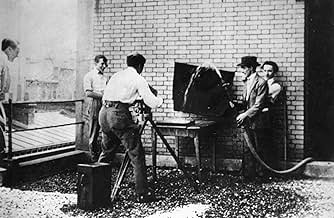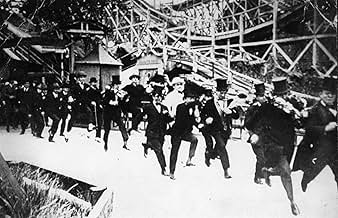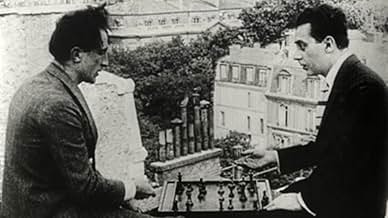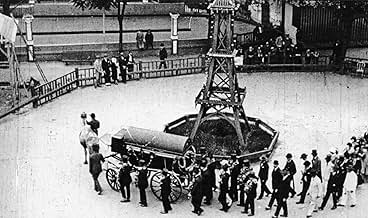Entr'acte
- 1924
- 22min
CALIFICACIÓN DE IMDb
7.3/10
4.4 k
TU CALIFICACIÓN
Agrega una trama en tu idiomaAn absolute dada movie. Somebody gets killed, his coffin gets out of control and after a chase it stops. The person gets out of it and let everybody who followed the coffin dissapear.An absolute dada movie. Somebody gets killed, his coffin gets out of control and after a chase it stops. The person gets out of it and let everybody who followed the coffin dissapear.An absolute dada movie. Somebody gets killed, his coffin gets out of control and after a chase it stops. The person gets out of it and let everybody who followed the coffin dissapear.
Inge Frïss
- La ballerine
- (as Mlle Frïss)
Man Ray
- Un joueur d'échecs
- (as Man-Ray)
Marcel Achard
- Un homme qui suit le corbillard
- (sin créditos)
Georges Auric
- Un homme qui suit le corbillard
- (sin créditos)
Georges Charensol
- Un homme qui suit le corbillard
- (sin créditos)
Georges Lacombe
- Un homme qui suit le corbillard
- (sin créditos)
Roger Le Bon
- Un homme qui suit le corbillard
- (sin créditos)
Jean Mamy
- Un homme qui suit le corbillard
- (sin créditos)
Rolf de Maré
- Un homme qui suit le corbillard
- (sin créditos)
Erik Satie
- Un homme qui charge le canon
- (sin créditos)
Pierre Scize
- Un homme qui suit le corbillard
- (sin créditos)
Louis Touchages
- Un homme qui suit le corbillard
- (sin créditos)
- Dirección
- Guionistas
- Todo el elenco y el equipo
- Producción, taquilla y más en IMDbPro
Opiniones destacadas
While not nearly as well-recognized or well-remembered as the Luis Bunuel classic "Un Chien Andalous" (1929), "Entr'acte" is a fairly known work in Dadaism of the 1920's, possibly one of the earliest shorts to focus on the avant-garde rather then attempt a story. Intended as an "entr'acte" (so the title suggests) for the French ballet "Relâche", the film appears to be a mere experimentation with effects while crafting a rather odd plot in the process--and more of a plot than most of the surrealistic works contain. Quite sadly, it was Rene Clair's only attempt at such a form of filmmaking, and had he gone on to lead the movement further he may have come up with even crazier material.
The image most of us remember when we think of this movie (if we do think of this movie, which many may not) is the shot of the bearded ballet dancer, reportedly played by Clair himself. This is a rather odd sight to see in a movie, and one you wouldn't normally see--likewise the rest of the short. Experimenting with slow motion, reverse motion, upside-down and side-to-side camera angles, and a number of dizzying double-exposures, the film's narrative is a rather odd one of a man shooting at a large egg only to be murdered by another man afterwards. This sets up the strange premise and the rest of the film is largely a crazy chase as the mourners of the man pursue his coffin after the hearse gets out of control. The ending, not to be spoiled, (although already spoiled by IMDb's summary) is a weird one to boot.
As others have commented, this short is hardly dark and is more of a comedy to watch than the later surrealist efforts. Plus, the opening sequences (such as the balloon dolls) hardly have anything to do with the rest of the short and the ballet dancer is entirely unconnected to the rest of it. It feels as though they were taking the first few minutes to experiment with other visuals before progressing with the true 'narrative', if one could call it that. Not to be considered a surrealist film, however; the wonderfully dizzying use of exposures is pure Dada all the way. A very creditable early effort in its exceedingly memorable imagery, and every bit as deserving to be a landmark classic as "Un Chien Andalou".
The image most of us remember when we think of this movie (if we do think of this movie, which many may not) is the shot of the bearded ballet dancer, reportedly played by Clair himself. This is a rather odd sight to see in a movie, and one you wouldn't normally see--likewise the rest of the short. Experimenting with slow motion, reverse motion, upside-down and side-to-side camera angles, and a number of dizzying double-exposures, the film's narrative is a rather odd one of a man shooting at a large egg only to be murdered by another man afterwards. This sets up the strange premise and the rest of the film is largely a crazy chase as the mourners of the man pursue his coffin after the hearse gets out of control. The ending, not to be spoiled, (although already spoiled by IMDb's summary) is a weird one to boot.
As others have commented, this short is hardly dark and is more of a comedy to watch than the later surrealist efforts. Plus, the opening sequences (such as the balloon dolls) hardly have anything to do with the rest of the short and the ballet dancer is entirely unconnected to the rest of it. It feels as though they were taking the first few minutes to experiment with other visuals before progressing with the true 'narrative', if one could call it that. Not to be considered a surrealist film, however; the wonderfully dizzying use of exposures is pure Dada all the way. A very creditable early effort in its exceedingly memorable imagery, and every bit as deserving to be a landmark classic as "Un Chien Andalou".
10m67165
This is it, for me! Absolute pure cinematic fun! This movie is not trying to tell you a story, although there is a plot about a funeral that ends up transforming into some unexpected events. I just had to laugh, and also marvel at some images that are simply beautiful, like some sort of silent visual music.
What the director does is basically a collage of absurd images and some camera tricks. These involve some artists of the time. I must say I am quite surprised by its freshness even today. Now I know where musical video clips come from! The first time I saw it, I was going to see some old silent movies, and this one was shown first, and I had no idea what it was all about. In a way, I still don't, and that's even better! Stop making sense for a while and start the fun!
What the director does is basically a collage of absurd images and some camera tricks. These involve some artists of the time. I must say I am quite surprised by its freshness even today. Now I know where musical video clips come from! The first time I saw it, I was going to see some old silent movies, and this one was shown first, and I had no idea what it was all about. In a way, I still don't, and that's even better! Stop making sense for a while and start the fun!
I watched Entr'acte (1924) during my first encounter with underground films, specifically in its avant-garde subgenre from the 1920s. This film, along with Buñuel-Dali's Un Chien Andalou (1927), immediately captivated me. Concurrently, I was studying Maya Dere's films, which inspired me to start creating my own underground/amateur/experimental short films between 2012 and 2015.
In Sheldon Renan's book on Underground Film, Entr'acte is considered one of the most impressive avant-garde films ever made. Renan labels it a "predecessor" of the underground film movement, which was then categorized as avant-garde. Entr'acte truly deserves this recognition because, considering the etymology of the term, it was undoubtedly a film ahead of its time. It stood apart from the mainstream Hollywood productions that dominated the era. René Clair, Man Ray, and Marcel Duchamp were acutely aware of the offerings to the strict bourgeois elite in Paris during a ballet concert. In the interlude between acts, they courageously introduced surrealist and dadaist ideas in film, challenging the norms of the time. This act demonstrated that Europe, particularly France, could also pioneer something revolutionary in this art form, breaking away from the conventions of Hollywood and mainstream cinema.
I would like to point out a particular scene in Entr'acte that could be interpreted as a metaphor for this subtle opposition to mainstream Hollywood and commercial films. In this scene, a man in Entr'acte fires a bullet from a shotgun directly at a balloon, which releases a dove. This imagery serves as a metaphor for liberation from the rigidity of standards not only within hegemonic Hollywood but also in cinema at large. It symbolizes the beginning of a new era, marked by the freedom to experiment with various forms and aesthetics. This period reached its peak in the 1960s, embracing a wide range of films that, while diverse in aesthetics, shared the spirit of freedom to explore cinematic possibilities. These filmmakers and artists, along with their successors, played a crucial role in advancing film techniques, many of which were developed specifically for their unconventional creations.
In Sheldon Renan's book on Underground Film, Entr'acte is considered one of the most impressive avant-garde films ever made. Renan labels it a "predecessor" of the underground film movement, which was then categorized as avant-garde. Entr'acte truly deserves this recognition because, considering the etymology of the term, it was undoubtedly a film ahead of its time. It stood apart from the mainstream Hollywood productions that dominated the era. René Clair, Man Ray, and Marcel Duchamp were acutely aware of the offerings to the strict bourgeois elite in Paris during a ballet concert. In the interlude between acts, they courageously introduced surrealist and dadaist ideas in film, challenging the norms of the time. This act demonstrated that Europe, particularly France, could also pioneer something revolutionary in this art form, breaking away from the conventions of Hollywood and mainstream cinema.
I would like to point out a particular scene in Entr'acte that could be interpreted as a metaphor for this subtle opposition to mainstream Hollywood and commercial films. In this scene, a man in Entr'acte fires a bullet from a shotgun directly at a balloon, which releases a dove. This imagery serves as a metaphor for liberation from the rigidity of standards not only within hegemonic Hollywood but also in cinema at large. It symbolizes the beginning of a new era, marked by the freedom to experiment with various forms and aesthetics. This period reached its peak in the 1960s, embracing a wide range of films that, while diverse in aesthetics, shared the spirit of freedom to explore cinematic possibilities. These filmmakers and artists, along with their successors, played a crucial role in advancing film techniques, many of which were developed specifically for their unconventional creations.
This short film was conceived (hence the title) by René Clair as a diversion for the interval of the absurdist-Dadaist ballet "Relâche", with screenplay by Francis Picabia and music by Erik Satie, both artists at the forefront of the contemporary Parisian avant-garde. At the supposed first night performance in 1924, expectant patrons were greeted by locked doors and a notice bearing the single word "Relâche", which is the French word for "No Show". How absurd! Oh what fun!
To accompany the film, Satie composed a striking piece of orchestral music (arguably more significant than that for the ballet itself), and as expected the remastered film now has this added as its soundtrack, and a pretty good job has been made of editing the music to the action on the screen. This latter consists of a medley of surrealist sequences, culminating in a funeral procession, led by a camel, which escalates into a manic chase, intercut with footage from a big dipper. At the end, all the mourners disappear into thin air one by one; the corpse lives on. How significant all this is, as a narrative itself, as well as in the history of cinema as a whole, I am not qualified to comment, but it must have been seen as groundbreaking at the time, as well as good absurdist fun.
At the start of the film is a short sequence of two men firing a cannon from the roof of the Théâtre des Champs-Elysées and jumping up and down, which was shown separately at the opening of the ballet, not as part of Entr'acte. The two men are Picabia and Satie themselves. This footage is especially poignant, as Satie himself was dead within a year.
For Region 2 viewers, Entr'acte is included as a bonus with Clair's much later masterpiece "Les Grandes Manoeuvres".
To accompany the film, Satie composed a striking piece of orchestral music (arguably more significant than that for the ballet itself), and as expected the remastered film now has this added as its soundtrack, and a pretty good job has been made of editing the music to the action on the screen. This latter consists of a medley of surrealist sequences, culminating in a funeral procession, led by a camel, which escalates into a manic chase, intercut with footage from a big dipper. At the end, all the mourners disappear into thin air one by one; the corpse lives on. How significant all this is, as a narrative itself, as well as in the history of cinema as a whole, I am not qualified to comment, but it must have been seen as groundbreaking at the time, as well as good absurdist fun.
At the start of the film is a short sequence of two men firing a cannon from the roof of the Théâtre des Champs-Elysées and jumping up and down, which was shown separately at the opening of the ballet, not as part of Entr'acte. The two men are Picabia and Satie themselves. This footage is especially poignant, as Satie himself was dead within a year.
For Region 2 viewers, Entr'acte is included as a bonus with Clair's much later masterpiece "Les Grandes Manoeuvres".
We were shown this film in a class where at least once during each class, I start to nod off to sleep. Maybe it's the time of day, or the too-dark lights, but even during one of the Jean Vigo films we saw it didn't grab me. This one did, however, as it is one of the best short films of the 20's, or at least one of the more ambitious ones of the time. There are plenty of Freudian symbols, or maybe spoofs and in-jokes on the symbols (i.e. phallic imagery, cannons, guns, balls, and obsessions with looking up women's skirts).
But more importantly there is an almost need to break through anything expectable. Unlike Bunuel's Un Chien Andalou, however, Entr'acte even goes for the manic and cartoon-like. Like Bunuel's film, there COULD be a certain thread of a story in the proceeding, if you try to take one to mind- here the story could be the unexpected tragedy of death turned up on its own head. However there is also the latter part of the film, which involves a large group running after (in trademark, hilarious fast-motion film) a hearse running down a road. It's a kind of peak of stimulating silent-film cinema, where everything being done can now be just as easily done- and is- on a daily basis by music video directors.
Yet Clair is so inventive with his techniques, of pushing a speed and tempo with his style, that it works well despite making no sense on the surface. It's a film made in the heights of French impressionism and surrealism, and the almost sheer confidence of the filmmaker here propels it into being unforgettable in a way. Most will seek out the Bunuel early works first, of course, but along the way this is worth a shot. At the least, you'll have your own interpretation once its done, not shoved down your throat.
But more importantly there is an almost need to break through anything expectable. Unlike Bunuel's Un Chien Andalou, however, Entr'acte even goes for the manic and cartoon-like. Like Bunuel's film, there COULD be a certain thread of a story in the proceeding, if you try to take one to mind- here the story could be the unexpected tragedy of death turned up on its own head. However there is also the latter part of the film, which involves a large group running after (in trademark, hilarious fast-motion film) a hearse running down a road. It's a kind of peak of stimulating silent-film cinema, where everything being done can now be just as easily done- and is- on a daily basis by music video directors.
Yet Clair is so inventive with his techniques, of pushing a speed and tempo with his style, that it works well despite making no sense on the surface. It's a film made in the heights of French impressionism and surrealism, and the almost sheer confidence of the filmmaker here propels it into being unforgettable in a way. Most will seek out the Bunuel early works first, of course, but along the way this is worth a shot. At the least, you'll have your own interpretation once its done, not shoved down your throat.
¿Sabías que…?
- TriviaThe ballet "Relâche" ("Theatre Closed") premiered at the Théâtre des Champs Elyseés in Paris on December 4, 1924. Based on a book and with settings by Francis Picabia, it was a ballet in two acts commissioned and staged by the Ballets Suédois of Rolf de Maré, with choreography by Jean Börlin. As the title "Entr'acte" implies, this film was shown between the two acts, with music by Erik Satie.
- ErroresObvious stand-in for the close-up of Rolf de Maré getting kicked in head, which sends him (via reverse motion) flying back into the end title. The "kick" itself is clearly achieved through reverse motion.
- Versiones alternativasThere is an Italian edition of this film on DVD, distributed by DNA Srl (2 Films on a single DVD). The film has been re-edited with the contribution of film historian Riccardo Cusin. This version is also available for streaming on some platforms.
- ConexionesEdited into Avant-garde Cinema (1960)
Selecciones populares
Inicia sesión para calificar y agrega a la lista de videos para obtener recomendaciones personalizadas
Detalles
- Tiempo de ejecución22 minutos
- Color
- Mezcla de sonido
- Relación de aspecto
- 1.33 : 1
Contribuir a esta página
Sugiere una edición o agrega el contenido que falta

Principales brechas de datos
By what name was Entr'acte (1924) officially released in Canada in English?
Responda





















